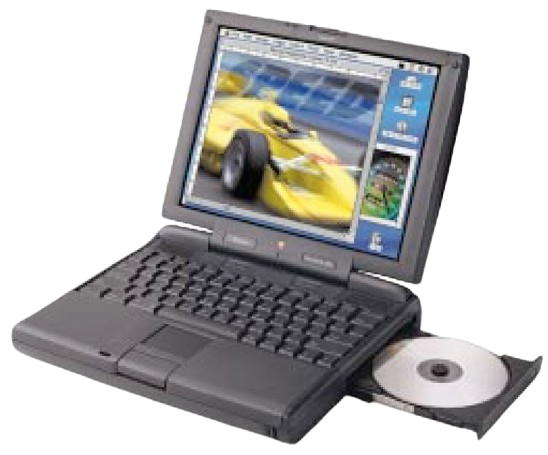
PowerBook G3 (Kanga)
The PowerBook G3 "Kanga" was the first Apple laptop to be powered by the PowerPC G3 processor. It was little more than a spec-bump of the PowerBook 3400c, sharing the same design and many components with it. It was only sold for a handful of months before it was replaced with the next-gen Wallstreet models.
The Kanga never got official Mac OS X support due to its outdated architecture. In fact, it was the only G3 Mac to not support it. In spite of this, you can run OS X on a Kanga (with a few catches) by using XPostFacto.
Specifications
| Spec | Details |
|---|---|
| Release Date | November 1997 |
| Discontinuation Date | May 1998 |
| Processor | CPU Type: Soldered BGA PowerPC G3 @250MHz Bus Speed: 50MHz L2 Cache: 256KB |
| RAM | PowerBook G3 Kanga Proprietary Standard: 32MB Soldered Maximum: 160MB |
| Hard Disk | 2.5" IDE Uses proprietary adapter: Yes Standard: 5GB |
| Display | 12.1" TFT/Active Matrix Color LCD @800x600 |
| GPU | Chips & Technologies 65554 - 2MB VRAM |
| Main Battery | - Lithium Ion (Sony, 17670 cells) - Compatible with PB190/5300 NiMH Batteries |
| PRAM Battery | 6-cell VARTA NiMH |
| Power Supply | 24V RCA-style jack - same as the Duo/1400/G3/iBook Clamshell chargers. Any with that plug will work. - Shipping charger is Apple P/N M4896 |
| Disk Drives | PowerBook 3400c/G3 Kanga Modular Bay (backwards compatible with 190/5300 modules) with the following available modules: - 3.5" 1.44MB Floppy Drive - CD-ROM Drive - ZIP Drive - MO Drive - Others? |
| PC Cards | 2x PCMCIA Slots - Unofficially CardBus compatible |
| Networking | Modem/Ethernet Combo Card (using a single port) |
| Other I/O | - 1x Serial - 1x ADB - 1x HDI-30 SCSI - 1x VGA Out - 1x Line Out - 1x Mic In - Infrared |
| Pointing Device | Trackpad |
| Minimum Mac OS | Mac OS 8.0 |
| Maximum Mac OS | Mac OS 9.1 (officially) Mac OS X 10.2.8 (unofficially) |
Resources
 Service Manual |
|---|
Upgrades
SSD Upgrade
See our page on IDE SSDs for more info.
From the options on that page, I'd recommend the IDE to SE adapter.
CPU Upgrades
The CPU on the Kanga is soldered in place, so there were no upgrades made for it.
Common Faults & Maintenance
The PowerBook G3 Kanga can be a rather unreliable laptop, due mainly to functions of time.
PRAM Battery Leaks
The Kanga uses a 6-cell Varta battery pack to back up the PRAM settings for the laptop. The problem with this battery is that it uses Nickel Metal-Hydride chemistry, which is prone to leakage over time. As expected, this has become an all too common problem for the Kanga. What makes this all worse is that the battery is placed directly over the logic board, making it the first part to get hit. This makes buying one untested a pretty big gamble, with the odds of getting a working system rather low. If you have a Kanga, the time is now to get that battery out, as they will all end up leaking, it is only a matter of time.
Power/DC Board Failure
Much like the 5300 and 3400 series, the Kanga uses a seperate Power board placed under the trackpad to regulate and control the power for the laptop. Without this board, the Kanga will not turn on, and it appears to be rather prone to failure. There doesn't seem to be one cause, sometimes a recap will get them working again, sometimes not. If you have a dead Kanga that has not had a battery leak, you should look to the power board first.
Brittle Plastics
Much like other 1990s laptops (including those not made by Apple!), the Kanga suffers from brittle plastic. Take all precautions necessary to prevent plastic cracking. Handle the laptop carefully while in use, and package it extremely well if you need to ship it. The brittle nature of the plastic also leads to broken display hinges. To prevent them from damage, avoid opening and closing the display as much as possible, and reinforce the plastic that the hinges screw into with epoxy or superglue. One way of avoiding hinge use is to store the laptop open, so that you don't need to open/shut the hinge each time you take the laptop out for use.
Page last updated (MM/DD/YYYY): 03/20/2025
Update Reason: image replaced
Back-Navigation
Home < Macintosh Portal < PowerBook < PowerBook G3 (Kanga)